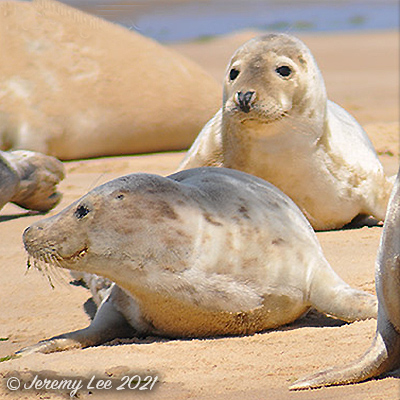
 |
|
Scientific Classifications explained » Amphibians » Ants » Aphids » Bees » Beetles » Birds » Bugs » Butterflies » Caterpillars » Damselflies » Dragonflies » Earwigs » Flies » Frog/Leafhoppers » Fungi » Galls » Grasshoppers » Harvestmen » Hoverflies » Lacewings » Ladybirds » Leaf Mines » Lichens » Mammals » Millipedes » Mosses » Moths » Sawflies » Slugs » Snails » Spiders » Trees » Wasps » Wild Flowers » Woodlice |
UK Nature > Mammals > Halichoerus grypus

Scientific Name: Halichoerus grypus Common Name: Grey Seal Halichoerus grypus, otherwise known as the Grey seal, has grey and brown fur, sometimes with a pattern of blotches; no ears visible; long muzzle; nostrils parallel; larger and darker than common seal, with flat or convex profile to its head (the common seal has a concave profile). Grey seals around Great Britain are found mainly along exposed rocky northern and western coasts. They also occur in the south west and off the east coast, around the Isle of May and the Farne Islands off Northumberland. Between the tides they haul themselves out on to rocks, usually on uninhabited offshore islands; though some haul-outs are on secluded mainland beaches. Grey seals are gregarious at these haul-outs, sometimes forming large groups of several hundred animals, especially when they are moulting their fur in the spring. They are not, however, very sociable and keep a distance between one another. About two-thirds of grey seals' time is spent at sea where they hunt and feed. In the autumn grey seals congregate at traditional sites on land to breed. The timing of births varies around the coast, beginning in September in West Wales, in October in western Scotland, and as late as November in the Farne Islands. Sand eels and cod are their most important foods, but grey seals are opportunistic feeders and probably take whatever fish are most abundant. |
|

https://www.uknature.co.uk is a website dedicated to showing the immense diversity of UK nature and wildlife. Our vast range of habitats, from lowland arable to snow covered mountains, from storm-ravaged coastlines to peaceful inland freshwater lakes and rivers, from dry, sandy heaths to deciduous and coniferous forests, all these habitats contribute to the abundance of UK nature. We have wild birds in huge numbers either residing or visiting our shores (597 recorded species as at July 2013) and we must also not forget the humble back garden with its grass lawns, flower beds filled with nectar rich flowers, shrubs and trees, all designed to attract huge numbers of insects such as bees, moths, butterflies and hoverflies; and finally the small ponds which provide safe havens for frogs, toads, newts and even slow worms and grass snakes. www.uknature.co.uk is the showcase for my personal passion, photographing uknature in all its glory. I sincerely hope you all enjoy the fruits of my labours. This site and all images contained therein is © Jeremy Lee 2004 - 2021. All Rights Reserved. Site design by Jeremy Lee. Site development & IT Support by Stuart Lee. |